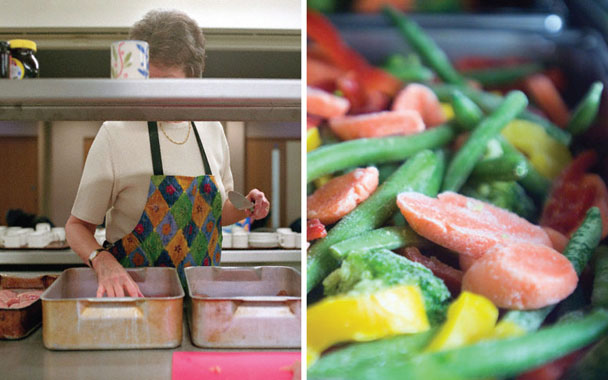Remember “meal-assembly” stores, the concept that was supposed to revolutionize home cooking? According to The New York Times, the shops are starting to flounder. Hundreds of owners have gone out of business; others are thinking up new services to offer, and the original idea seems destined for that overstuffed closet where frazzled homemakers stash the dreams they can’t bear to discard. This one is going to be especially hard to give up: a fresh and fragrant dinner that magically appears when summoned, homemade without being made at home, factory-produced by Mom herself.
Here’s how meal assembly works: You drive to a strip mall and park at a storefront with a name like Super Suppers, or Let’s Dish, or Dinner by Design. The place is set up with food-preparation stations, each outfitted with a recipe and all the necessary ingredients, chopped and measured and ready to use. You assemble the ingredients—seasoning precut portions of raw chicken, for instance, and then spooning sauce ingredients into a plastic bag. Moving from station to station you can make and package a dozen entrées in two hours, following the recipes provided. You don’t cook anything; you may not even need to handle a knife. You take the packages home and put them in the freezer. Now you’ve got—well, it’s not completely clear what you’ve got, but theoretically you can file it under “dinner.” All you have to do is thaw and bake.
For the first several years, meal assembly was a boomtown. Some 1,400 stores sprang up across the country, and many homemakers were enthusiastic. They liked serving food made with fresh ingredients, and the cost was reasonable, often around $3 or $4 per serving. Most importantly, it was a step up, or at least sideways, from takeout. “I feel like it’s cooking because you have to put it together,” a pleased customer told the Arkansas Democrat-Gazette. But recently, growth has slowed and stores are shutting down. Some have been able to survive only by selling fully prepared meals, either refrigerated or frozen—in other words, takeout. What went wrong? Nobody seems to know. One shop owner outside Tampa, who closed the place after eight months, told The New York Times that homemakers just refused to think ahead about meals. “The last thing anyone wants to do here is plan dinner,” she said.
Maybe, but I’m guessing the real problem is an overdose of magical thinking—specifically, the magical thinking that puts dinner on the table without so much as a moment’s planning or worrying. It’s an old, old dream, and in this country it’s a classic feature of futuristic writing about ideal societies (at least when it’s women who are doing the imagining). Utopia has been a popular theme in women’s fiction since the 19th century, and the early writers in this genre loved describing what daily life would look like if women had a hand in arranging it. Some of these feminist visionaries made a point of ending war; others figured out how to dispense with men; but first and foremost the utopian writers got rid of the private kitchen. There was no way the women of the future were going to spend their days desperately trying to think of something different to do with cauliflower. One of the great, iconic scenes in women’s utopian fiction is the moment when some female of the future presses a button and suddenly dinner appears—hot and delicious, delivered to the table through an intricate system of tunnels, tubes, and dumbwaiters.




 Pinterest
Pinterest


